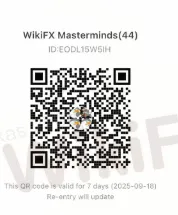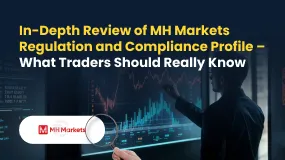简体中文
繁體中文
English
Pусский
日本語
ภาษาไทย
Tiếng Việt
Bahasa Indonesia
Español
हिन्दी
Filippiiniläinen
Français
Deutsch
Português
Türkçe
한국어
العربية
Standard Deviation in Forex: How to Apply This to Your Trading Strategy?
Abstract:Do you recall the concept of standard deviation being taught in your school days? The concept, which measures the variation within a set of data points relative to the mean average of the dataset. A greater standard deviation hints at higher variability. On the other hand, a lower standard deviation means lower variability from the mean. But what is standard deviation in forex, and how can you apply it to your trading strategy? This is what we will discuss here.

Do you recall the concept of standard deviation being taught in your school days? The concept, which measures the variation within a set of data points relative to the mean average of the dataset. A greater standard deviation hints at higher variability. On the other hand, a lower standard deviation means lower variability from the mean. But what is standard deviation in forex, and how can you apply it to your trading strategy? This is what we will discuss here.
How Does Standard Deviation Apply to Trading?
Understanding how standard deviation applies to forex trading requires visualizing data points as closing prices, where the mean represents the average price over the evaluated period. Forex traders frequently use standard deviation to determine the risk or volatility attached to currency pairs. Forex pairs with high volatility offer a wide range of risk. Forex pairs with increased volatility witness intense price fluctuations, leading to a higher standard deviation. In contrast, forex pairs with lower price changes will translate to a lower standard deviation. At the same time, several trading indicators factor in standard deviation to compute risk vs return when applying risk management. When applying standard deviation to the return rate, it can measure the historical volatility of a trade or investment.
Analyzing the Forex Market Using Standard Deviation
Standard deviation helps measure the current price action of the forex market. For instance, market tops with increasing standard deviation are a sign of indecisive traders. Whereas market tops with low standard deviation are a potential indicator of a more mature forex market. If we talk about the market bottoms with high standard deviation, it hints at panicked sell-offs. The low standard deviation here indicates a potential disinterest of traders now.
Standard Deviation Calculation
Calculating standard deviation is easy through these steps-
- Figure out the mean average closing price for every period across the timespan you are evaluating.
- Ascertain the deviation for each period by deducting the average price from the closing price.
- Compute the square of each deviation.
- Add all squared deviations.
- Divide the overall amount by the number of periods.
- Calculate the square root of the quotient found in the earlier step.
Interestingly, most forex trading platforms feature automatic standard deviation calculation of any given period.
Standard Deviation-led Forex Trading Strategies
Standard deviation, as discussed above, is used as a tool for market volatility measurement. However, traders also use it to calculate several other indicators to gain a highly comprehensive analysis. As you go further, you will witness the application of standard deviation in your forex trading strategy.
Risk Assessment
Standard deviation is considered a vital tool to measure volatility, which helps assess investment risks. Greater price swings and potential losses lurk with a greater standard deviation.
Investment Diversification
Traders also apply diversification as a strategy to reduce risks by investing in several currency pairs. With standard deviation, traders can compare the volatility of different currency pairs in their portfolios. A diversified portfolio would have currency pairs with varying standard deviations to reduce the impact of a single highly volatile currency pair.
Volatility Trading
Certain forex traders engage in volatility trading, a strategy to profit from price fluctuations regardless of where the market is moving. This strategy usually focuses on options and derivatives, and standard deviation helps figure out the magnitude of currency pair price fluctuations.
Stop Loss and Take Profit Orders
You can apply standard deviation to figure out the right stop loss and take profit levels. Amid a high standard deviation, you may need wider stop loss and take profit ranges to deal with the forex pair price volatility. A lower standard deviation, on the other hand, may need tighter ranges.
Bollinger Bands
Technical indicators such as Bollinger Bands use standard deviation to predict trends based on price movements. Bollinger bands use this to spot trend reversals and breakout points. These bands feature a moving average line and two lines plotted above and below the moving average at specific standard deviations. The standard deviation ranges demonstrate the overbought or oversold condition compared to its average price.
Mean Reversion
Mean reversion forms part of a fundamental analysis that indicates the potential reversal of a currency pair price to its historical mean or equilibrium. Here, standard deviation helps identify situations showcasing the deviation of a currency pairs price from its mean. It thus signals an opportunity to open a trade, assuming that the price will come back to its average.
Summing Up
Standard deviation serves as one of the most valuable tools in forex trading, helping traders gauge volatility, manage risk, and refine strategies with greater precision. By understanding how much prices deviate from their average, traders can make informed decisions on position sizing, stop-loss placement, and overall portfolio diversification. Whether you use it directly or through indicators like Bollinger Bands, standard deviation provides a statistical edge to anticipate market movements and identify potential opportunities. Mastering its application can transform your trading approach—from mere speculation to data-driven strategy.
To know more about technical indicator-based forex strategy, join WikiFX Masterminds.
1. Scan the QR code placed right at the bottom.
2. Download the WikiFX Pro app.
3. Afterward, tap the ‘Scan’ icon placed at the top right corner
4. Scan the code again.
5. Congratulations on joining the group.

Disclaimer:
The views in this article only represent the author's personal views, and do not constitute investment advice on this platform. This platform does not guarantee the accuracy, completeness and timeliness of the information in the article, and will not be liable for any loss caused by the use of or reliance on the information in the article.
Read more

KKR Exposed: Traders Allege Fund Scams, Withdrawal Denials & Regulatory Concerns
Do you witness a negative trading account balance on the KKR broker login? Does the broker prevent you from withdrawing your funds after making profits? Do you need to pay an extra margin for withdrawals? These trading issues have become common for traders at KKR. In this KKR broker review article, we have elaborated on the complaints. Take a look!

IG Launches 5% Cashback Offer for New UK Customers
IG cashback offer UK 2025 gives investors up to £100 back. Compare the best UK investment platforms with cashback today.

In-Depth Review of MH Markets Regulation and Compliance Profile – What Traders Should Really Know
This in-depth analysis provides a data-driven examination of the MH Markets regulation and compliance profile. Drawing primarily on verified data from the global broker inquiry app WikiFX, supplemented by public records, we will dissect the broker's multi-jurisdictional licensing, evaluate the real-world protections offered to traders, and interpret the warnings and ratings that define its standing in the competitive forex and CFD landscape.

In-Depth Stonefort Securities Commission Fees and Spreads Analysis for 2025
This comprehensive Stonefort Securities commission fees and spreads analysis aims to cut through the noise. We will dissect the broker's complete cost structure, from the spreads on its Elite account to its commission policies and the potential for hidden non-trading fees. Explore more.
WikiFX Broker
Latest News
Gratitude Beyond Borders: WikiFX Thank You This Thanksgiving
MH Markets Commission Fees and Spreads Analysis: A Data-Driven Breakdown for Traders
Alpha FX Allegations: Traders Claim Account Blocks, Withdrawal Denials and Security Breaches
How to Become a Profitable Forex Trader in Pakistan in 2025
CFTC Polymarket Approval Signals U.S. Relaunch 2025
Zipphy Exposed: No Valid Regulation, Risk Warning
KEY TO MARKETS Review: Are Traders Facing Withdrawal Delays, Deposit Issues & Trade Manipulation?
FCA Consumer Warning – FCA Warning List 2025
Australia’s Fraud-Intel Network Exposes $60M in Scams
Malaysia’s SkyLine Guide Top 25 Brokers Are Out!
Currency Calculator



